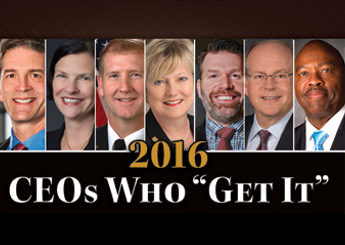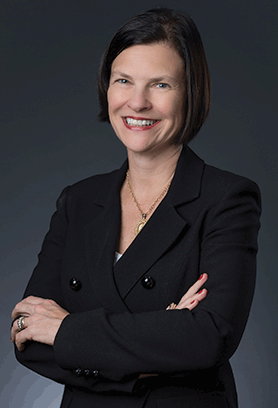2016 CEOs Who 'Get It'
The National Safety Council recognizes seven leaders who demonstrate a personal commitment to worker safety and health

 |
 |
Andrea E. Bertone
President
Duke Energy International
Houston, TX
 |
Accomplishments
DUKE ENERGY INTERNATIONAL, a wholly owned subsidiary of Duke Energy Corp., is the fourth largest private generator of electricity in Central and South America based on net capacity of approximately 4,400 MW. DEI owns, operates and manages power generation facilities in Argentina, Brazil, Chile, Ecuador, El Salvador, Guatemala and Peru. The organization employs 1,178 workers. |
Why is safety a core value at your organization?
We believe that the success and future of our organization depends on our employees and their safety. Safety affects everything – the well-being of each person, the interests of their families, the diverse communities in which we operate and the ability to meet our commitments to our customers. Safety is a DEI core value because we care for our people and it is the right thing to do – anything else would be unacceptable. As a core value, we establish and promote safety expectations, manage our business and operate to achieve these expectations, and monitor our safety performance to sustain a safety culture where everyone – from senior executives to front-line employees to contractors – has a personal responsibility to proactively look out for each other at all times.
Describe your personal journey to becoming a leader who “gets it.” What experiences or lessons brought you to where you are now?
Professionally, I came from a non-technical, legal background without any direct experience in leading or managing safety. However, as a result of a near-tragic family event, I came to realize that safety has a direct human impact. When I assumed the role of DEI President six years ago, I quickly noticed that our organization focused a lot on measuring injury rates. Some leaders in our organization had a tendency to view injuries as simply unfortunate events rather than human beings who had experienced a potentially life-changing event. It wasn’t so much a tolerance for injuries, but an apparent lack of compassion around the personal impact of an injury. I knew we had to make a transformation to humanize safety while critically examining our safety processes. So, working closely with my talented staff in our Environmental, Health and Safety Department, I visited each of our facilities in Argentina, Brazil, Chile, El Salvador, Ecuador, Guatemala and Peru to personally listen to employees and our management teams about how to improve our safety culture. This helped tremendously to validate my belief about the human side of safety, and led me to get away from just looking at injury rates.
To sum up my personal safety journey, I discovered that safety is about people – not just injury rates – and the overriding need to challenge everyone to do their best to ensure a proactive safety culture.
What is the biggest obstacle to safety at your organization, and how do you work to overcome it?
One of the biggest obstacles to safety within our organization was that we had many historical, in-country cultures, which were varied and highly hierarchical. Safety was being practiced and managed in many different ways. Together with my DEI-Corporate EHS Department staff, we worked to standardize our safety practices, including incident and near-miss reporting, through safety procedures and provided training to all levels of the organization to ensure consistent implementation. This reduced variations, eliminated confusion and inconsistency, and, at the same time, allowed us to recognize internal best practices. We also established a central Safety and Sustainability Committee composed of the top 10 leaders within DEI. This team helps me ensure consistent implementation and compliance with our vision, strategy and goals. Additionally, committee members drive specific risk reduction initiatives, translating them to fit each country’s needs. They also help us in the corporate office to better understand their needs, so that we can improve the way we communicate, promote and ensure the success of future initiatives.
How do you instill a sense of safety in employees on an ongoing basis?
Actions, not words, are what build credibility – this is how I believe you lead safety. Executives shouldn’t simply talk about safety but demonstrate their commitment through their own personal actions. For example, following DEI’s 2013 acquisition of the Yungay Power Plant in Chile, I ordered a 48-hour delay prior to initiating start-up operation, what we called a “Safety Stand Down.” Despite this delay costing the company days of dispatch, it allowed time for all of our new plant personnel to receive the required DEI safety training. I feel that this type of action showed real, personal commitment by the leadership team to carry out our safety expectations, despite impacts to earnings. Because we are unable to put a dollar value on the life of a team member, safety will always be more important than financial results. The lessons learned from this experience were so rewarding and impactful that we now require proactive safety stand downs annually at every facility. These events reinforce the importance we place on our safety culture and encourage employees to provide feedback to continually improve our safety performance. We never want to lose sight of safety, even in a changing and dynamic business environment.
As a result of my initial plant visits, we developed a new program that requires my executives to join me and actually roll up our sleeves to work at a production job at least once each year. By doing this, we have come to understand the realities and hazards that our employees and contractors face every day, and it allows us to directly interface and understand their concerns. We found that this helped break down the barriers that existed between management and employees and facilitated two-way communication of concerns, suggestions and feedback on ways to improve safety. We want our leadership team to understand and support the same core values and to preserve an environment in which everyone has a shared vision.
The lessons learned from these visits and interactions with employees were needed to clearly state our safety expectations, increase personal motivation and commitment, and build trust between management and employees so that we can change things together.
One valuable lesson learned from this experience was that people wanted to do the “right thing” but often didn’t have a good understanding of what that “thing” was. I subsequently commissioned the development and implementation of DEI’s Safety Behavior Standards to clearly define our expectations to all DEI employees. These standards set specific behavioral leadership expectations for all employees, no matter what position they had within the company. We subsequently measured our maturity against these standards at every DEI-operated facility throughout Latin America. This provided us with even more detailed insights on culture gaps, and we continue these behavioral assessments to this day.
We conduct a Safety and Sustainability Conference for the top 85 leaders of DEI annually. We communicate and discuss new or changing standards and initiatives to DEI leadership and the positive impacts that they should have. The conference also provides a vehicle for DEI leaders to discuss the successes they have had and to learn from others on ways to improve their own safety programs.
How does your organization measure safety? What are the leading indicators that show you how safe your organization is, and where do you see room for improvement?
DEI is the international business unit of Duke Energy Corp., the USA’s largest utility. As such, we decided to use US-OSHA definitions in the international arena to be consistent across the enterprise. We required each in-country business unit to define injuries according to the local definition, for regulatory compliance purposes, as well as the definitions used by OSHA to compare our performance to other Duke Energy business units.
As a result of the great work and programs that have been implemented by our employees, we reduced our employee Total Incident Case Rate by 84 percent during the last six years. Our 2014 TICR was 0.14, and our 2015 year-to-date results are 0.07. While this represents only one employee injury for the entire year, we were not satisfied. Two years ago, we launched a five-year 2018 Year Zero Safety Strategy. The goal is to have an entire calendar year without an employee recordable injury in or before 2018.
In addition to these lagging metrics, we also utilize four to five leading metrics. The specific requirements of each leading metric may change over the years, but they are typically identified as a result of historical injuries and near misses. We recognize that leading metrics are based on past performance, so we want to improve this process by establishing a more dynamic and real-time method to update leading metrics based on changing risks and international benchmarking.
What role does off-the-job safety play in your organization’s overall safety program?
As a native of Brazil, I intimately understand that family is the core of Latin American life. We want DEI to be a part of, and involved in, the overall family experience. Therefore, we sponsor “Family Day” events where employees and their families come together to boost camaraderie and share safety practices. These events help families understand their role in safety and how to be supportive of family members working at our company. DEI has a wellness program to promote healthy lifestyles for our employees at work and at home. As an example, our Central America operations had healthy cooking classes for the employees as part of this program.
During DEI’s Latin American Women Entrepreneurs Program, a DEI Corporate Social Responsibility Program, which encourages women to participate in their family’s economic success, I have seized every opportunity to share the key to running a successful business – prioritizing safety.
In 2014, our Central America operations were impacted by a sudden outbreak of the new highly aggressive mosquito-borne virus known as Chikungunya. Approximately half of our employees and over 150 contractors were infected by the virus, resulting in a direct impact on our operations. The leadership team immediately implemented a proactive mosquito control program around our plants; initiated training for our employees, contractors and their families on how to reduce mosquito associated risks; and donated mosquito netting and other protective supplies for use at their homes. As a result of these efforts, the infection rate was reduced and a solid bond was formed with our immediate community and employees.
Traditionally, it has been a challenge to find safe, qualified contractors in developing countries. DEI’s approach has been to proactively share our safety processes and to qualify the contractors ourselves. This strategy has allowed us to hold routine meetings with all contractors to train them on our programs and set stringent safety expectations. As a result, contractor professionalism and work quality have soared and their incident rates have decreased. DEI’s contractor training programs have enhanced contractor safety practices and allowed them to qualify for work with other multinationals that also value safe operations.
Post a comment to this article
Safety+Health welcomes comments that promote respectful dialogue. Please stay on topic. Comments that contain personal attacks, profanity or abusive language – or those aggressively promoting products or services – will be removed. We reserve the right to determine which comments violate our comment policy. (Anonymous comments are welcome; merely skip the “name” field in the comment box. An email address is required but will not be included with your comment.)

